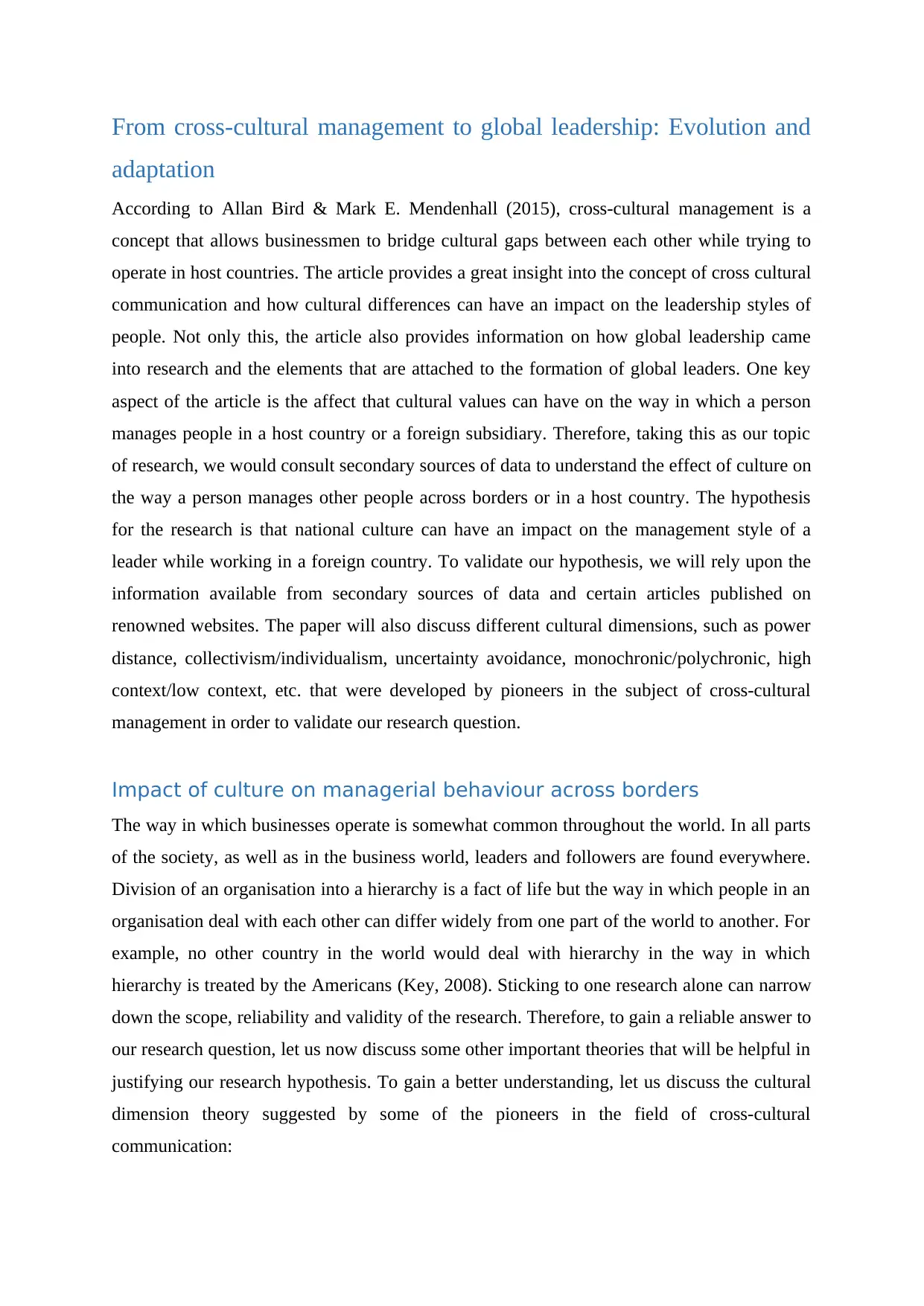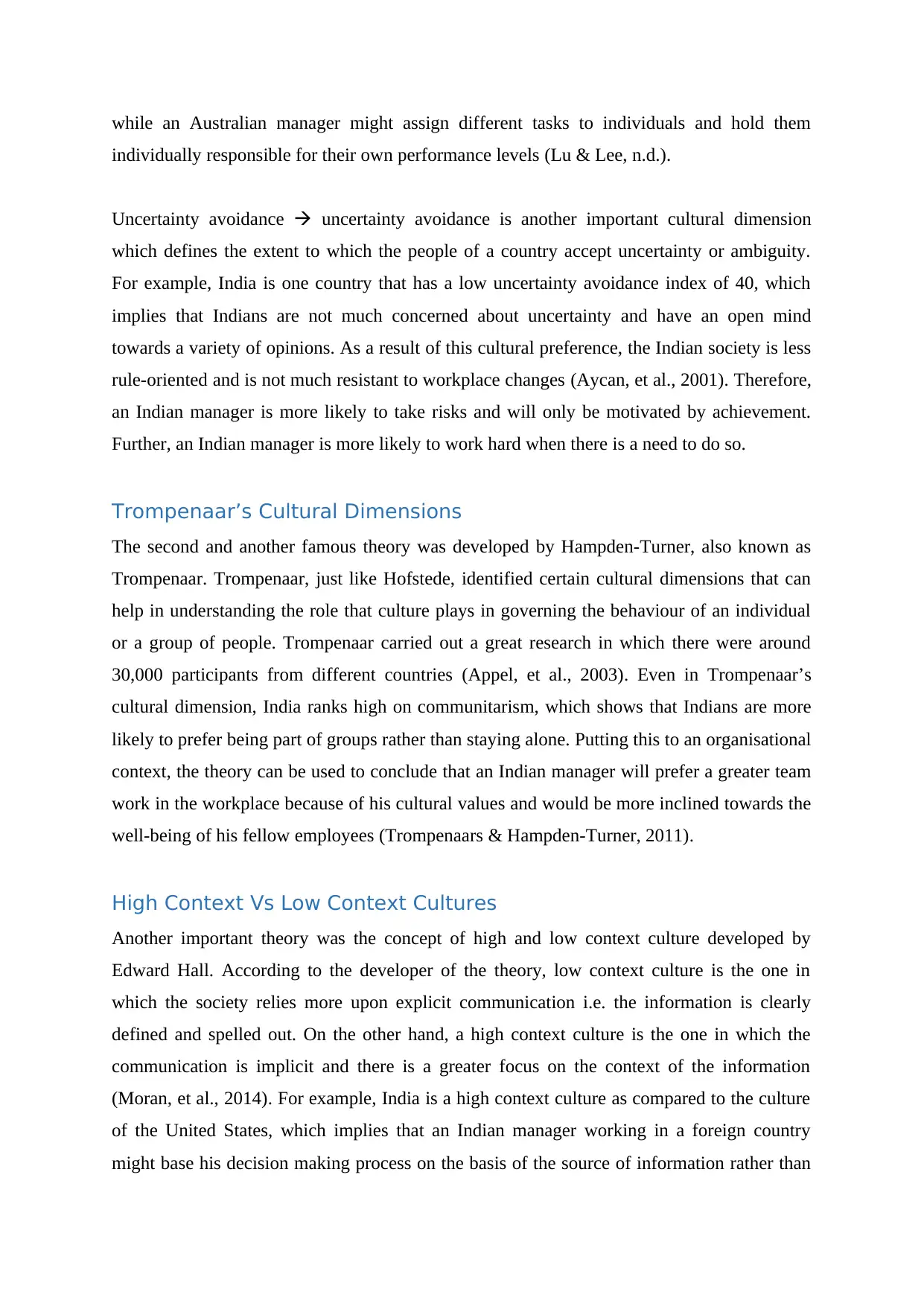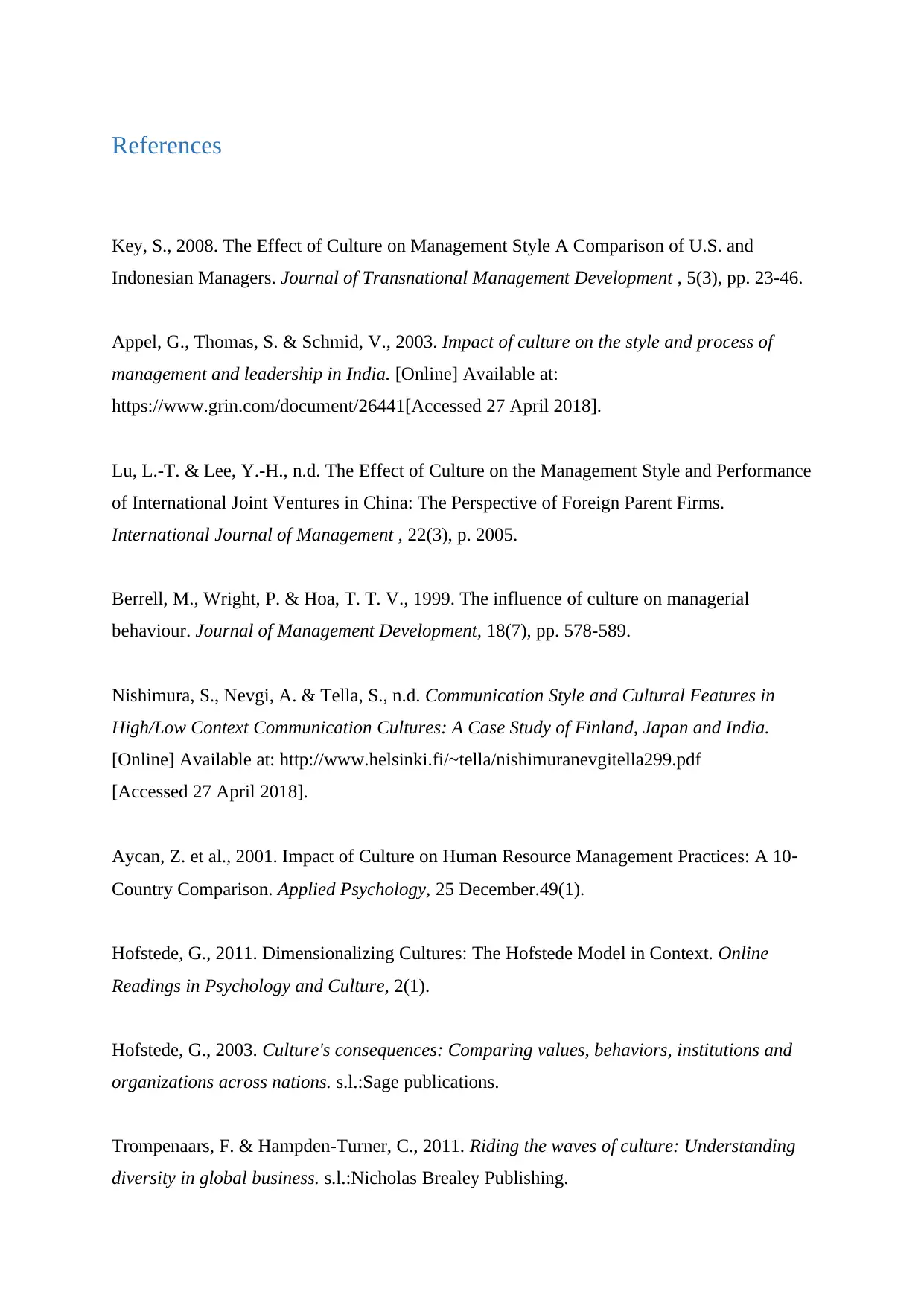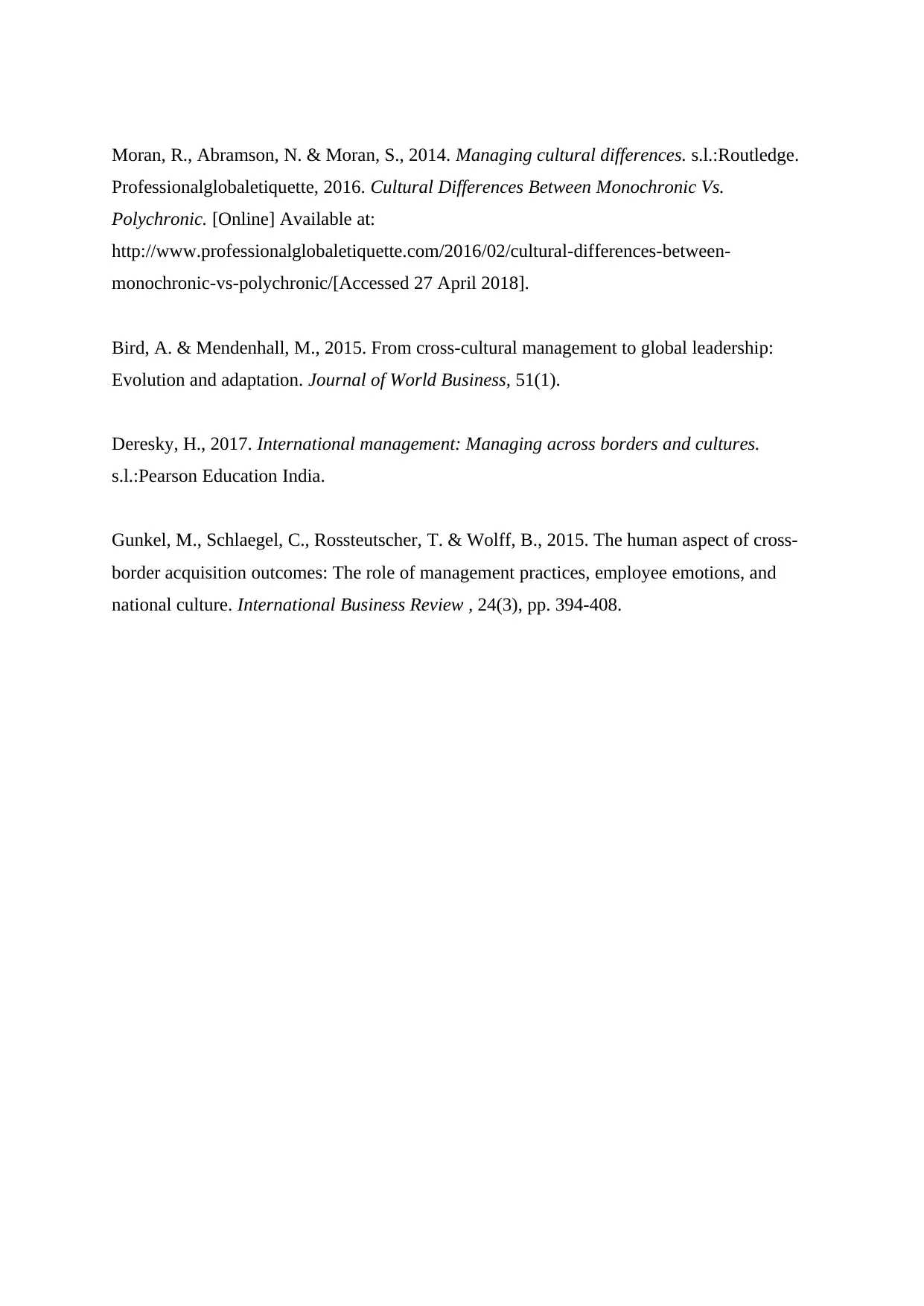Impact of Culture on Managerial Behaviour in Cross-Cultural Management - 715821
VerifiedAdded on 2023/06/12
|9
|2725
|98
AI Summary
This report explores the impact of culture on managerial behaviour in cross-cultural management. It discusses Hofstede's and Trompenaar's cultural dimensions, high context vs low context cultures, and monochronic and polychronic cultures. The report validates the hypothesis that national culture can affect the management style of a leader while working in a foreign country. It emphasizes the importance of cross-cultural communication and training for multinational companies.
Contribute Materials
Your contribution can guide someone’s learning journey. Share your
documents today.

CROSS-CULTURAL MANAGEMENT – 715821
Secure Best Marks with AI Grader
Need help grading? Try our AI Grader for instant feedback on your assignments.

Table of Contents
Introduction..............................................................................................................................3
From cross-cultural management to global leadership: Evolution and adaptation..........4
Impact of culture on managerial behaviour across borders........................................................4
Hofstede’s Cultural Dimensions.....................................................................................................5
Trompenaar’s Cultural Dimensions..............................................................................................6
High Context Vs Low Context Cultures........................................................................................6
Monochronic and Polychronic Cultures by Lewis........................................................................7
Conclusion.................................................................................................................................7
References.................................................................................................................................8
Introduction..............................................................................................................................3
From cross-cultural management to global leadership: Evolution and adaptation..........4
Impact of culture on managerial behaviour across borders........................................................4
Hofstede’s Cultural Dimensions.....................................................................................................5
Trompenaar’s Cultural Dimensions..............................................................................................6
High Context Vs Low Context Cultures........................................................................................6
Monochronic and Polychronic Cultures by Lewis........................................................................7
Conclusion.................................................................................................................................7
References.................................................................................................................................8

Introduction
The spread of globalisation, liberalisation and privatisation has had a huge impact on the
global business world. The business world has become more complex and competitive than
ever before. Globalisation has increased the level of competition between rival firms and has
brought customers and companies from all around the world to a common market. The spread
of globalisation also forced business organisations to expand their operations overseas and
establish foreign relations in order to remain competitive.
When multinational companies carry out their operations in different parts of the world, they
have to deal with people originating from diverse cultural backgrounds. Culture here can be
defined as a set of ethics, morals, values, cuisines, language, etc. that governs the social
conduct of an individual or a group of people. The communication that takes place between
people belonging to different cultural backgrounds is known as cross-cultural communication
(Gunkel, et al., 2015).
Culture can have a huge impact on the way a person sends, receives and perceives verbal as
well as non-verbal information and data. When communicating with a person belonging to a
different culture, it is important for businessmen to value the cultural preferences of the other
person in order to establish effective business relations and also to avoid offending them
(Deresky, 2017). Thus, the subject of cross-cultural communication has been gaining a lot of
importance ever since the business world has been exposed to globalisation.
In this report, we will base our research on the work created by Allan Bird and Mark E.
Mendenhall, 2016 titled ‘From cross-cultural management to global leadership: Evolution
and adaption.’ From this article, we would gather knowledge about some important cross-
cultural concepts, such as ‘Culture and Business’, ‘Culture and Communication’, ‘Culture
and MNCs’, etc. Based on our findings from this article, we will conduct a detailed
investigation into one of such topics by referring to the literature and by using secondary
sources of data.
The spread of globalisation, liberalisation and privatisation has had a huge impact on the
global business world. The business world has become more complex and competitive than
ever before. Globalisation has increased the level of competition between rival firms and has
brought customers and companies from all around the world to a common market. The spread
of globalisation also forced business organisations to expand their operations overseas and
establish foreign relations in order to remain competitive.
When multinational companies carry out their operations in different parts of the world, they
have to deal with people originating from diverse cultural backgrounds. Culture here can be
defined as a set of ethics, morals, values, cuisines, language, etc. that governs the social
conduct of an individual or a group of people. The communication that takes place between
people belonging to different cultural backgrounds is known as cross-cultural communication
(Gunkel, et al., 2015).
Culture can have a huge impact on the way a person sends, receives and perceives verbal as
well as non-verbal information and data. When communicating with a person belonging to a
different culture, it is important for businessmen to value the cultural preferences of the other
person in order to establish effective business relations and also to avoid offending them
(Deresky, 2017). Thus, the subject of cross-cultural communication has been gaining a lot of
importance ever since the business world has been exposed to globalisation.
In this report, we will base our research on the work created by Allan Bird and Mark E.
Mendenhall, 2016 titled ‘From cross-cultural management to global leadership: Evolution
and adaption.’ From this article, we would gather knowledge about some important cross-
cultural concepts, such as ‘Culture and Business’, ‘Culture and Communication’, ‘Culture
and MNCs’, etc. Based on our findings from this article, we will conduct a detailed
investigation into one of such topics by referring to the literature and by using secondary
sources of data.

From cross-cultural management to global leadership: Evolution and
adaptation
According to Allan Bird & Mark E. Mendenhall (2015), cross-cultural management is a
concept that allows businessmen to bridge cultural gaps between each other while trying to
operate in host countries. The article provides a great insight into the concept of cross cultural
communication and how cultural differences can have an impact on the leadership styles of
people. Not only this, the article also provides information on how global leadership came
into research and the elements that are attached to the formation of global leaders. One key
aspect of the article is the affect that cultural values can have on the way in which a person
manages people in a host country or a foreign subsidiary. Therefore, taking this as our topic
of research, we would consult secondary sources of data to understand the effect of culture on
the way a person manages other people across borders or in a host country. The hypothesis
for the research is that national culture can have an impact on the management style of a
leader while working in a foreign country. To validate our hypothesis, we will rely upon the
information available from secondary sources of data and certain articles published on
renowned websites. The paper will also discuss different cultural dimensions, such as power
distance, collectivism/individualism, uncertainty avoidance, monochronic/polychronic, high
context/low context, etc. that were developed by pioneers in the subject of cross-cultural
management in order to validate our research question.
Impact of culture on managerial behaviour across borders
The way in which businesses operate is somewhat common throughout the world. In all parts
of the society, as well as in the business world, leaders and followers are found everywhere.
Division of an organisation into a hierarchy is a fact of life but the way in which people in an
organisation deal with each other can differ widely from one part of the world to another. For
example, no other country in the world would deal with hierarchy in the way in which
hierarchy is treated by the Americans (Key, 2008). Sticking to one research alone can narrow
down the scope, reliability and validity of the research. Therefore, to gain a reliable answer to
our research question, let us now discuss some other important theories that will be helpful in
justifying our research hypothesis. To gain a better understanding, let us discuss the cultural
dimension theory suggested by some of the pioneers in the field of cross-cultural
communication:
adaptation
According to Allan Bird & Mark E. Mendenhall (2015), cross-cultural management is a
concept that allows businessmen to bridge cultural gaps between each other while trying to
operate in host countries. The article provides a great insight into the concept of cross cultural
communication and how cultural differences can have an impact on the leadership styles of
people. Not only this, the article also provides information on how global leadership came
into research and the elements that are attached to the formation of global leaders. One key
aspect of the article is the affect that cultural values can have on the way in which a person
manages people in a host country or a foreign subsidiary. Therefore, taking this as our topic
of research, we would consult secondary sources of data to understand the effect of culture on
the way a person manages other people across borders or in a host country. The hypothesis
for the research is that national culture can have an impact on the management style of a
leader while working in a foreign country. To validate our hypothesis, we will rely upon the
information available from secondary sources of data and certain articles published on
renowned websites. The paper will also discuss different cultural dimensions, such as power
distance, collectivism/individualism, uncertainty avoidance, monochronic/polychronic, high
context/low context, etc. that were developed by pioneers in the subject of cross-cultural
management in order to validate our research question.
Impact of culture on managerial behaviour across borders
The way in which businesses operate is somewhat common throughout the world. In all parts
of the society, as well as in the business world, leaders and followers are found everywhere.
Division of an organisation into a hierarchy is a fact of life but the way in which people in an
organisation deal with each other can differ widely from one part of the world to another. For
example, no other country in the world would deal with hierarchy in the way in which
hierarchy is treated by the Americans (Key, 2008). Sticking to one research alone can narrow
down the scope, reliability and validity of the research. Therefore, to gain a reliable answer to
our research question, let us now discuss some other important theories that will be helpful in
justifying our research hypothesis. To gain a better understanding, let us discuss the cultural
dimension theory suggested by some of the pioneers in the field of cross-cultural
communication:
Secure Best Marks with AI Grader
Need help grading? Try our AI Grader for instant feedback on your assignments.

Hofstede’s Cultural Dimensions
Hofstede was one of the pioneers in the subject of cross-cultural communication. In his
theory, Hofstede has identified six cultural dimensions that can have an impact on the
preferences of an individual or can help in distinguishing one country from another. The
theory was extensively used by researchers in which each country was given a score on each
dimension, which made it easier to understand the cultural preferences of the countries and
how they differed from each other. The cultural dimensions suggested by Hofstede are given
below:
Power Distance Index this cultural dimension talks about the degree to which a society
accepts or rejects unequal distribution of power. Societies or countries with high power
distance have a hierarchical setup and each member has a place which needs no justification.
On the other hand, countries that score low on power index do not accept unequal distribution
of power. For example, India is a country that scores 77 on power distance index while
United States has a score of 40 on the same (Hofstede, 2011). As a result, an Indian manager
working in an American company might demand higher power and authority over his or her
employees and might even expect his subordinates to show respect to him, as a result of the
position that he holds in the hierarchy of the organisation. On the other hand, an American
manager working in India might be more open with his or her subordinates and would
empower them to take decisions on their own (Hofstede, 2003). Therefore, the cultural
differences between the two countries will have an impact on the way in which a manager
from one country manages his or her subordinates in the other country.
Individualism Individualism is a cultural dimension that defines how closely the people of
a society are linked with each other. Countries that rate high on individualism prefer a loosely
knit society and individuals in such societies are expected to take care of their own needs on
their own. On the other hand, countries with low individualism (also termed as collectivism)
have a preference for closely knot societies and look after each other. For example, China
scores 20 on this dimension while Australia scores 90 (Berrell, et al., 1999). This implies that
the Chinese have a closely knit society as compared to that of Australia. As a result, a
Chinese manager looking after business operations in Australia might motivate his or her
employees to work in teams and holds the entire team responsible for the overall performance
Hofstede was one of the pioneers in the subject of cross-cultural communication. In his
theory, Hofstede has identified six cultural dimensions that can have an impact on the
preferences of an individual or can help in distinguishing one country from another. The
theory was extensively used by researchers in which each country was given a score on each
dimension, which made it easier to understand the cultural preferences of the countries and
how they differed from each other. The cultural dimensions suggested by Hofstede are given
below:
Power Distance Index this cultural dimension talks about the degree to which a society
accepts or rejects unequal distribution of power. Societies or countries with high power
distance have a hierarchical setup and each member has a place which needs no justification.
On the other hand, countries that score low on power index do not accept unequal distribution
of power. For example, India is a country that scores 77 on power distance index while
United States has a score of 40 on the same (Hofstede, 2011). As a result, an Indian manager
working in an American company might demand higher power and authority over his or her
employees and might even expect his subordinates to show respect to him, as a result of the
position that he holds in the hierarchy of the organisation. On the other hand, an American
manager working in India might be more open with his or her subordinates and would
empower them to take decisions on their own (Hofstede, 2003). Therefore, the cultural
differences between the two countries will have an impact on the way in which a manager
from one country manages his or her subordinates in the other country.
Individualism Individualism is a cultural dimension that defines how closely the people of
a society are linked with each other. Countries that rate high on individualism prefer a loosely
knit society and individuals in such societies are expected to take care of their own needs on
their own. On the other hand, countries with low individualism (also termed as collectivism)
have a preference for closely knot societies and look after each other. For example, China
scores 20 on this dimension while Australia scores 90 (Berrell, et al., 1999). This implies that
the Chinese have a closely knit society as compared to that of Australia. As a result, a
Chinese manager looking after business operations in Australia might motivate his or her
employees to work in teams and holds the entire team responsible for the overall performance

while an Australian manager might assign different tasks to individuals and hold them
individually responsible for their own performance levels (Lu & Lee, n.d.).
Uncertainty avoidance uncertainty avoidance is another important cultural dimension
which defines the extent to which the people of a country accept uncertainty or ambiguity.
For example, India is one country that has a low uncertainty avoidance index of 40, which
implies that Indians are not much concerned about uncertainty and have an open mind
towards a variety of opinions. As a result of this cultural preference, the Indian society is less
rule-oriented and is not much resistant to workplace changes (Aycan, et al., 2001). Therefore,
an Indian manager is more likely to take risks and will only be motivated by achievement.
Further, an Indian manager is more likely to work hard when there is a need to do so.
Trompenaar’s Cultural Dimensions
The second and another famous theory was developed by Hampden-Turner, also known as
Trompenaar. Trompenaar, just like Hofstede, identified certain cultural dimensions that can
help in understanding the role that culture plays in governing the behaviour of an individual
or a group of people. Trompenaar carried out a great research in which there were around
30,000 participants from different countries (Appel, et al., 2003). Even in Trompenaar’s
cultural dimension, India ranks high on communitarism, which shows that Indians are more
likely to prefer being part of groups rather than staying alone. Putting this to an organisational
context, the theory can be used to conclude that an Indian manager will prefer a greater team
work in the workplace because of his cultural values and would be more inclined towards the
well-being of his fellow employees (Trompenaars & Hampden-Turner, 2011).
High Context Vs Low Context Cultures
Another important theory was the concept of high and low context culture developed by
Edward Hall. According to the developer of the theory, low context culture is the one in
which the society relies more upon explicit communication i.e. the information is clearly
defined and spelled out. On the other hand, a high context culture is the one in which the
communication is implicit and there is a greater focus on the context of the information
(Moran, et al., 2014). For example, India is a high context culture as compared to the culture
of the United States, which implies that an Indian manager working in a foreign country
might base his decision making process on the basis of the source of information rather than
individually responsible for their own performance levels (Lu & Lee, n.d.).
Uncertainty avoidance uncertainty avoidance is another important cultural dimension
which defines the extent to which the people of a country accept uncertainty or ambiguity.
For example, India is one country that has a low uncertainty avoidance index of 40, which
implies that Indians are not much concerned about uncertainty and have an open mind
towards a variety of opinions. As a result of this cultural preference, the Indian society is less
rule-oriented and is not much resistant to workplace changes (Aycan, et al., 2001). Therefore,
an Indian manager is more likely to take risks and will only be motivated by achievement.
Further, an Indian manager is more likely to work hard when there is a need to do so.
Trompenaar’s Cultural Dimensions
The second and another famous theory was developed by Hampden-Turner, also known as
Trompenaar. Trompenaar, just like Hofstede, identified certain cultural dimensions that can
help in understanding the role that culture plays in governing the behaviour of an individual
or a group of people. Trompenaar carried out a great research in which there were around
30,000 participants from different countries (Appel, et al., 2003). Even in Trompenaar’s
cultural dimension, India ranks high on communitarism, which shows that Indians are more
likely to prefer being part of groups rather than staying alone. Putting this to an organisational
context, the theory can be used to conclude that an Indian manager will prefer a greater team
work in the workplace because of his cultural values and would be more inclined towards the
well-being of his fellow employees (Trompenaars & Hampden-Turner, 2011).
High Context Vs Low Context Cultures
Another important theory was the concept of high and low context culture developed by
Edward Hall. According to the developer of the theory, low context culture is the one in
which the society relies more upon explicit communication i.e. the information is clearly
defined and spelled out. On the other hand, a high context culture is the one in which the
communication is implicit and there is a greater focus on the context of the information
(Moran, et al., 2014). For example, India is a high context culture as compared to the culture
of the United States, which implies that an Indian manager working in a foreign country
might base his decision making process on the basis of the source of information rather than

relying upon research based evidence. On the other hand, if an American manager is
appointed in India to manage people, he or she might base his or her decision making process
on the basis of evidence based research even if a person sitting at a higher position is the
source of information (Nishimura, et al., n.d.).
Monochronic and Polychronic Cultures by Lewis
Lewis developed another cultural dimension on the basis of extensive study and research. In
his study, he categorised different countries into two categories, i.e. monochronic and
polychronic. Countries that had a monochronic culture had a preference for doing a single
task at one point of time whereas countries that had a polychronic culture had a preference for
doing multiple tasks at the same time (Professionalglobaletiquette, 2016) (Bird &
Mendenhall, 2015). Interaction between the two types of cultures can cause a great problem
for the managers. For example, India has been categorised as a polychronic culture, i.e.
Indians have a preference for flexibility and can try to do multiple tasks at once in an
unplanned manner. On the other hand, Americans have a monochronic culture, i.e.
Americans will do only one task at a time in a planned manner. Therefore, an Indian manager
working in an American subsidiary might expect his or her employees to take care of
multiple things at once whereas the Americans might be able to fulfil the expectations of their
manager.
Conclusion
Based on secondary sources of data and the information collected above, it can be easily seen
that there are a number of cultural dimensions which can be attributed to the cultural
differences that exists between different countries. Cultural dimensions like power distance,
collectivism/individualism, uncertainty avoidance, monochronic/polychronic, high
context/low context, etc. can have a high impact on the managerial preferences of leaders
while working in a foreign subsidiary. Therefore, our hypothesis for the research that national
culture can have an impact on the management style of a leader while working in a foreign
country can be validated on the basis of the information given above. As a result, it is
important for multinational companies to focus on cross cultural communication and
adequately train and develop their staff in case they are selected to be sent for expatriate
programs.
appointed in India to manage people, he or she might base his or her decision making process
on the basis of evidence based research even if a person sitting at a higher position is the
source of information (Nishimura, et al., n.d.).
Monochronic and Polychronic Cultures by Lewis
Lewis developed another cultural dimension on the basis of extensive study and research. In
his study, he categorised different countries into two categories, i.e. monochronic and
polychronic. Countries that had a monochronic culture had a preference for doing a single
task at one point of time whereas countries that had a polychronic culture had a preference for
doing multiple tasks at the same time (Professionalglobaletiquette, 2016) (Bird &
Mendenhall, 2015). Interaction between the two types of cultures can cause a great problem
for the managers. For example, India has been categorised as a polychronic culture, i.e.
Indians have a preference for flexibility and can try to do multiple tasks at once in an
unplanned manner. On the other hand, Americans have a monochronic culture, i.e.
Americans will do only one task at a time in a planned manner. Therefore, an Indian manager
working in an American subsidiary might expect his or her employees to take care of
multiple things at once whereas the Americans might be able to fulfil the expectations of their
manager.
Conclusion
Based on secondary sources of data and the information collected above, it can be easily seen
that there are a number of cultural dimensions which can be attributed to the cultural
differences that exists between different countries. Cultural dimensions like power distance,
collectivism/individualism, uncertainty avoidance, monochronic/polychronic, high
context/low context, etc. can have a high impact on the managerial preferences of leaders
while working in a foreign subsidiary. Therefore, our hypothesis for the research that national
culture can have an impact on the management style of a leader while working in a foreign
country can be validated on the basis of the information given above. As a result, it is
important for multinational companies to focus on cross cultural communication and
adequately train and develop their staff in case they are selected to be sent for expatriate
programs.
Paraphrase This Document
Need a fresh take? Get an instant paraphrase of this document with our AI Paraphraser

References
Key, S., 2008. The Effect of Culture on Management Style A Comparison of U.S. and
Indonesian Managers. Journal of Transnational Management Development , 5(3), pp. 23-46.
Appel, G., Thomas, S. & Schmid, V., 2003. Impact of culture on the style and process of
management and leadership in India. [Online] Available at:
https://www.grin.com/document/26441[Accessed 27 April 2018].
Lu, L.-T. & Lee, Y.-H., n.d. The Effect of Culture on the Management Style and Performance
of International Joint Ventures in China: The Perspective of Foreign Parent Firms.
International Journal of Management , 22(3), p. 2005.
Berrell, M., Wright, P. & Hoa, T. T. V., 1999. The influence of culture on managerial
behaviour. Journal of Management Development, 18(7), pp. 578-589.
Nishimura, S., Nevgi, A. & Tella, S., n.d. Communication Style and Cultural Features in
High/Low Context Communication Cultures: A Case Study of Finland, Japan and India.
[Online] Available at: http://www.helsinki.fi/~tella/nishimuranevgitella299.pdf
[Accessed 27 April 2018].
Aycan, Z. et al., 2001. Impact of Culture on Human Resource Management Practices: A 10‐
Country Comparison. Applied Psychology, 25 December.49(1).
Hofstede, G., 2011. Dimensionalizing Cultures: The Hofstede Model in Context. Online
Readings in Psychology and Culture, 2(1).
Hofstede, G., 2003. Culture's consequences: Comparing values, behaviors, institutions and
organizations across nations. s.l.:Sage publications.
Trompenaars, F. & Hampden-Turner, C., 2011. Riding the waves of culture: Understanding
diversity in global business. s.l.:Nicholas Brealey Publishing.
Key, S., 2008. The Effect of Culture on Management Style A Comparison of U.S. and
Indonesian Managers. Journal of Transnational Management Development , 5(3), pp. 23-46.
Appel, G., Thomas, S. & Schmid, V., 2003. Impact of culture on the style and process of
management and leadership in India. [Online] Available at:
https://www.grin.com/document/26441[Accessed 27 April 2018].
Lu, L.-T. & Lee, Y.-H., n.d. The Effect of Culture on the Management Style and Performance
of International Joint Ventures in China: The Perspective of Foreign Parent Firms.
International Journal of Management , 22(3), p. 2005.
Berrell, M., Wright, P. & Hoa, T. T. V., 1999. The influence of culture on managerial
behaviour. Journal of Management Development, 18(7), pp. 578-589.
Nishimura, S., Nevgi, A. & Tella, S., n.d. Communication Style and Cultural Features in
High/Low Context Communication Cultures: A Case Study of Finland, Japan and India.
[Online] Available at: http://www.helsinki.fi/~tella/nishimuranevgitella299.pdf
[Accessed 27 April 2018].
Aycan, Z. et al., 2001. Impact of Culture on Human Resource Management Practices: A 10‐
Country Comparison. Applied Psychology, 25 December.49(1).
Hofstede, G., 2011. Dimensionalizing Cultures: The Hofstede Model in Context. Online
Readings in Psychology and Culture, 2(1).
Hofstede, G., 2003. Culture's consequences: Comparing values, behaviors, institutions and
organizations across nations. s.l.:Sage publications.
Trompenaars, F. & Hampden-Turner, C., 2011. Riding the waves of culture: Understanding
diversity in global business. s.l.:Nicholas Brealey Publishing.

Moran, R., Abramson, N. & Moran, S., 2014. Managing cultural differences. s.l.:Routledge.
Professionalglobaletiquette, 2016. Cultural Differences Between Monochronic Vs.
Polychronic. [Online] Available at:
http://www.professionalglobaletiquette.com/2016/02/cultural-differences-between-
monochronic-vs-polychronic/[Accessed 27 April 2018].
Bird, A. & Mendenhall, M., 2015. From cross-cultural management to global leadership:
Evolution and adaptation. Journal of World Business, 51(1).
Deresky, H., 2017. International management: Managing across borders and cultures.
s.l.:Pearson Education India.
Gunkel, M., Schlaegel, C., Rossteutscher, T. & Wolff, B., 2015. The human aspect of cross-
border acquisition outcomes: The role of management practices, employee emotions, and
national culture. International Business Review , 24(3), pp. 394-408.
Professionalglobaletiquette, 2016. Cultural Differences Between Monochronic Vs.
Polychronic. [Online] Available at:
http://www.professionalglobaletiquette.com/2016/02/cultural-differences-between-
monochronic-vs-polychronic/[Accessed 27 April 2018].
Bird, A. & Mendenhall, M., 2015. From cross-cultural management to global leadership:
Evolution and adaptation. Journal of World Business, 51(1).
Deresky, H., 2017. International management: Managing across borders and cultures.
s.l.:Pearson Education India.
Gunkel, M., Schlaegel, C., Rossteutscher, T. & Wolff, B., 2015. The human aspect of cross-
border acquisition outcomes: The role of management practices, employee emotions, and
national culture. International Business Review , 24(3), pp. 394-408.
1 out of 9
Related Documents
Your All-in-One AI-Powered Toolkit for Academic Success.
+13062052269
info@desklib.com
Available 24*7 on WhatsApp / Email
![[object Object]](/_next/static/media/star-bottom.7253800d.svg)
Unlock your academic potential
© 2024 | Zucol Services PVT LTD | All rights reserved.





